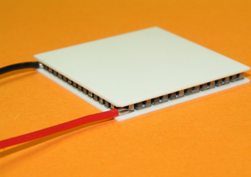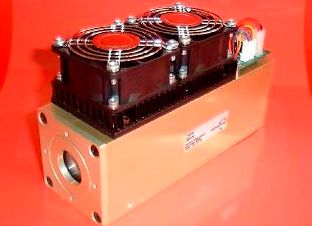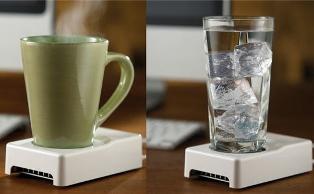Categories: Interesting Facts, Interesting electrical news
Number of views: 86993
Comments on the article: 8
Peltier effect: the magic effect of electric current
 The beginning of the 19th century. The Golden Age of Physics and Electrical Engineering. In 1834, the French watchmaker and naturalist Jean-Charles Peltier placed a drop of water between the bismuth and antimony electrodes, and then passed an electric current through the circuit. To his amazement, he saw that the drop had suddenly frozen.
The beginning of the 19th century. The Golden Age of Physics and Electrical Engineering. In 1834, the French watchmaker and naturalist Jean-Charles Peltier placed a drop of water between the bismuth and antimony electrodes, and then passed an electric current through the circuit. To his amazement, he saw that the drop had suddenly frozen.
The thermal effect of electric current on the conductors was known, but the opposite effect was akin to magic. You can understand Peltier’s feelings: this phenomenon at the junction of two different areas of physics — thermodynamics and electricity — causes a sense of wonder today.
The cooling problem was not as acute as it is today. Therefore, the Peltier effect was addressed only after almost two centuries, when electronic devices appeared, for the operation of which miniature cooling systems were required. Virtue Peltier cooling elements are small dimensions, the absence of moving parts, the possibility of cascade connections to obtain large temperature differences.
In addition, the Peltier effect is reversible: when the polarity of the current through the module changes, the cooling is replaced by heating, so it is easy to implement systems of accurate temperature maintenance - thermostats. The disadvantage of Peltier elements (modules) is low efficiency, which requires summing up large current values to obtain a noticeable temperature difference. The complexity is represented by the removal of heat from the plate opposite to the cooled plane.
But first things first. First, let us try to consider the physical processes responsible for the observed phenomenon. Without plunging into the abyss of mathematical calculations, we’ll just try to understand the nature of this interesting physical phenomenon on the “fingers”.
Since we are talking about temperature phenomena, physicists, for the convenience of a mathematical description, replace the vibrations of the atomic lattice of a material with a certain gas consisting of, as it were, particles - phonons.
The temperature of the phonon gas depends on the ambient temperature and the properties of the metal. Then any metal is a mixture of electron and phonon gases in thermodynamic equilibrium. When two different metals come into contact in the absence of an external field, a “hotter” electron gas penetrates into a “colder” zone, creating a contact potential difference known to everyone.
When applying the potential difference to the transition, i.e. as current flows through the boundary of two metals, electrons take energy from the phonons of one metal and transfer it to the phonon gas of another. With a change in polarity, the transfer of energy, which means that heating and cooling, change sign.
In semiconductors, electrons and “holes” are responsible for energy transfer, but the mechanism of heat transfer and the appearance of a temperature difference is preserved. The temperature difference increases until high-energy electrons are depleted. Temperature equilibrium sets in. This is the modern picture of description Peltier effect.
It is clear from it that Peltier element performance depends on the selection of a pair of materials, current strength and speed of heat removal from the hot zone. For modern materials (usually semiconductors), the efficiency is 5-8%.
And now about the practical application of the Peltier effect. To increase it, individual thermocouples (junctions of two different materials) are assembled into groups consisting of tens and hundreds of elements. The main purpose of such modules is the cooling of small objects or microcircuits.
Thermoelectric Cooling Module
Modules based on the Peltier effect are widely used in night-vision devices with a matrix of infrared receivers.Charge-coupled microcircuits (CCDs), which are also used today in digital cameras, require deep cooling to record images in the infrared region. Peltier modules cool infrared detectors in telescopes, active laser elements to stabilize the radiation frequency, crystal oscillators in exact time systems. But these are all military and special applications.
Recently, Peltier modules have found application in household products. Mainly in automotive technology: air conditioners, portable refrigerators, water coolers.
An example of the practical use of the Peltier effect
The most interesting and promising application of modules is computer technology. High-performance microprocessors, processors, and video card chips emit a lot of heat. To cool them, high-speed fans are used, which create significant acoustic noise. The use of Peltier modules as part of combined cooling systems eliminates noise with significant heat removal.
Compact USBcooler using Peltier modules
And, finally, a logical question: will Peltier modules replace conventional cooling systems in compression household refrigerators? Today it is unprofitable in terms of efficiency (low efficiency) and price. The cost of powerful modules is still quite high.
But technology and materials science do not stand still. It is impossible to exclude the possibility of the appearance of new, cheaper materials with high efficiency and a high Peltier coefficient. Already today there are reports from research laboratories about the amazing properties of nanocarbon materials that can radically change the situation with efficient cooling systems.
There have been reports of high thermoelectric figure of merit of clastrates - solid solutions similar in structure to hydrates. When these materials come out of research laboratories, completely silent coolers with unlimited service life will replace our usual home models.
P.S. OneOh of the most interesting features thermoelectric technology is that she can Not only use electrical energy to get heat and cold, but also thanks to her canbut start the reverse process, and, for example, get electric energy from heat.
An example of how you can get electricity from heat from using thermoelectric module (thermoelectric generator) look at this video:
What do you think about this? Waiting for your comments!
See also at e.imadeself.com
:



